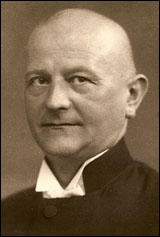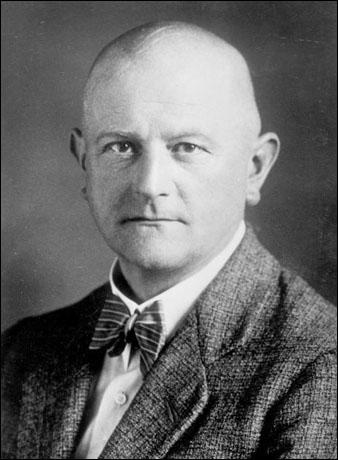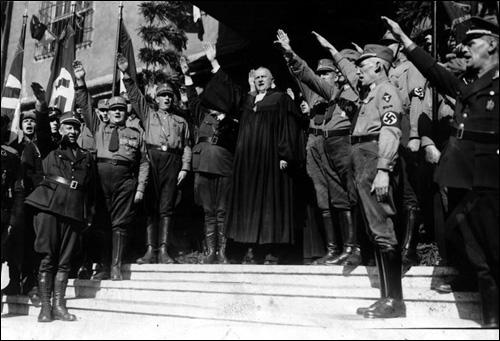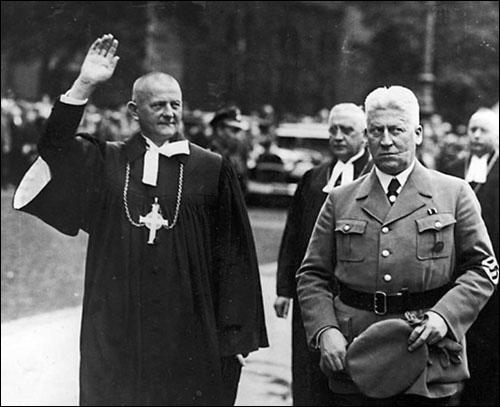Ludwig Müller

Ludwig Müller was born in Gütersloh, Germany, on 23rd June, 1883. He attended the Pietist Evangelical Gymnasium before studying Protestant theology at the Martin Luther University of Halle-Wittenberg. He worked as a school inspector (1905-08) before becoming a parish priest in Rödinghausen. (1)
On the outbreak of the First World War he served as a Navy chaplain in the coastal town of Wilhelmshaven. Müller became an ardent nationalist and when five Berlin pastors issued a plea for peace by negotiation he supported the 160 of their colleagues who replied that "pacifism is blasphemy against God." (2)
Müller was an early supporter of Adolf Hitler and the Nazi Party and openly expressed anti-semitic views. According to Konrad Heiden, the author of Hitler: A Biography (1936) Müller, who was assigned to the First Military Command in Königsberg, persuaded his commander to attend a mass meeting at which Hitler was to speak." (3)
In 1931 he helped establish the German Christian movement. (4) The following year the group issued the statement: "We stand on the ground of positive Christianity. We profess an affirmative faith in Christ, fitting our race and being in accordance with the German Lutheran mind and heroic piety. Mere compassion is charity and leads to presumption, paired with bad conscience, and effeminates a nation. We know something about Christian obligation and charity towards the helpless, but we also demand the protection of the nation from the unfit and inferior. We see a great danger to our nationality in the Jewish Mission. It promises to allow foreign blood into our nation... Marriages between Jews and Germans must be prohibited." (5)
Lutheran bishops began urging people to vote for Hitler. Before the 1932 Presidential election, Otto Dibelius, the Bishop of Kurmark stated that in the past he had always encouraged people to vote for Protestant candidates. However, this time he urged the people to vote for Hitler: "Among the candidates there is once again a Catholic, namely Hitler. But he is not a candidate of the Roman Catholic Church, rather the leader of the great national movement, to which millions of the Protestants belong." (6)

Müller's career blossomed after Hitler became Chancellor. On 4th April, 1933, he was appointed to the post of confidant and plenipotentiary for all problems concerning the Protestant Church. Hitler wanted the abolition of the 28 autonomous regional Churches and to replace it with a centralized Reich Church. He expected the new church to support his doctrines on race and nationalism. (7)
Müller made controversial comments including the view that "Christ was an Aryan" and that traditional Christianity was "whole-hearted Bolshevism under a tinsel of metaphysics". (8) Müller and the German Christians attempted to merge the Christian doctrine with Nazi ideology and with German mythology. They also sought to purge the Christian religion of its Jewish roots. For example, Jesus of Nazareth was turned into an "Aryan hero" and attempts were made to remove Old Testament studies from the school curriculum. (9)
Hitler selected Ludwig Müller to become the new leader of the Reich Church. "Hitler's choice - on whose advice is unclear - had no obvious qualifications for the positions except a high regard for his own importance and an ardent admiration for the Reich Chancellor and his Movement." (10) Joseph Goebbels began a massive propaganda campaign and he was duly elected as Reich bishop on 23rd July, 1933. (11)
Müller was strongly supported by Professor Ernst Bergmann, who in 1934 issued the Twenty-Five Points of the German Religion. This included the following: (i) The Jewish Old Testament as well as parts of the New Testament are not suitable for the new Germany. (ii) Christ was not Jewish but a Nordic martyr put to death by the Jews, a warrior whose death rescued the world from Jewish influence. (iii) Adolf Hitler is the new Messiah sent to earth to save the world from the Jews. (12)

Susan Ottaway has argued that many Protestants saw Bergmann's theories as "utter drivel". She points out: "The second point alone high-lights the inconsistency of the doctrine. If Christ's death rescued the world from Jewish influence, why did the Nazis find it necessary to persecute them? The entire document was complete nonsense and utterly at odds with any conventional view of Christianity." (13)
Müller was popular with young pastors from lower-middle-class backgrounds or non-academic families. "Such men desired a Church whose members were soldiers from Jesus and the Fatherland, tough, hard and uncompromising. Muscular Christianity of this kind appealed particularly to young men who despised the feminization of religion through the involvement in charity, welfare and acts of compassion." (14)
Martin Niemöller was the pastor of the Church of Jesus Christ at Dahlem. He had been a long-term supporter of Hitler and had made speeches where he argued that Germany needed a Führer. In his sermons he also espoused Hitler's views on race and nationality. During the 1933 General Election he described the programme of the Nazi Party as a "renewal movement based on a Christian moral foundation".
However, Niemöller objected to the election of Müller and on 21st September, 1933, he wrote to all German pastors inviting them to join him in his newly formed Pastors' Emergency League. An estimated 7,000 pastors, around 40 per cent of all evangelical churchmen, joined him including Dietrich Bonhoffer and it eventually became known as the Confessional Church. (15) The organisation published a Theological Declaration rejecting the idea that religion should be subordinate to the dictates of a political system. (16)

It was Ludwig Müller's role to deal with the Confessional Church. He managed to persuade the old-Prussian general synod adopted the Aryan Paragraph, effectively defrocking clergy of Jewish descent and even clergy married to non-Aryans. The angered many Protestants and people such as Müller were condemned as heretics and claimed that he was introducing "Nazified Christianity." (17)
Albert Speer claims that Hitler had high expectations of Ludwig Müller and hoped that the German Protestant Church "could become the established church, as in England". (18) Hitler was disappointed by Müller's performance and in 1935 he turned over religious issues to a Reich Church Commission. (19) Hans Kerrl, was appointed as Minister of Ecclesiastical Affairs but he also failed to merge "German Protestantism with Nazi ideology". (20)
Ludwig Müller committed suicide on 31st July 1945.
Primary Sources
(1) Ludwig Müller, statement on the beliefs of German Christians (June, 1932)
We stand on the ground of positive Christianity. We profess an affirmative faith in Christ, fitting our race and being in accordance with the German Lutheran mind and heroic piety.
Mere compassion is charity and leads to presumption, paired with bad conscience, and effeminates a nation. We know something about Christian obligation and charity towards the helpless, but we also demand the protection of the nation from the unfit and inferior.
We see a great danger to our nationality in the Jewish Mission. It promises to allow foreign blood into our nation... Marriages between Jews and Germans must be prohibited.
Student Activities
Kristallnacht (Answer Commentary)
Adolf Hitler's Early Life (Answer Commentary)
Heinrich Himmler and the SS (Answer Commentary)
Trade Unions in Nazi Germany (Answer Commentary)
Adolf Hitler v John Heartfield (Answer Commentary)
Hitler's Volkswagen (The People's Car) (Answer Commentary)
Women in Nazi Germany (Answer Commentary)
German League of Girls (Answer Commentary)
